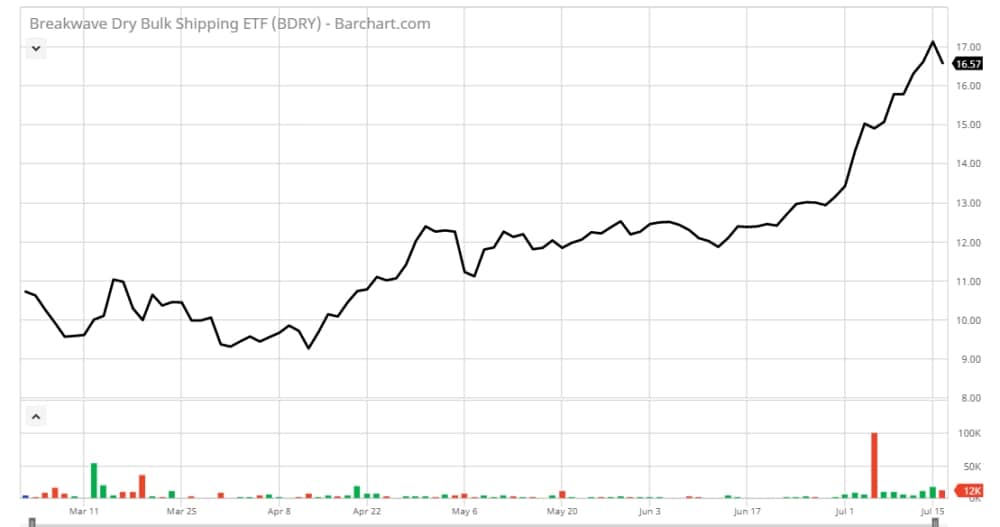Dry bulk – iron ore, coal, grains and other mineral and agricultural commodities – is by far the world’s largest cargo segment. With rates rising after an extended slump, what’s the best way for investors to capture the upside in this massive market?
One of the most innovative options is the Breakwave Dry Bulk Shipping ETF (NYSE: BDRY), an exchange-traded fund (ETF) launched in March 2018 that owns and tracks bulker freight futures. Not surprisingly given what’s going on with bulker rates, BDRY is now gaining more traction after a quiet start.
FreightWaves conducted an extensive interview with John Kartsonas, founder of Breakwave Advisors, which created BDRY. He discussed how his product contrasts with other dry bulk investment options, as well as his views on what’s ahead for the dry bulk market.
Between March 31 and July 15, the price of BDRY surged 84 percent. “Over the last six months, our trading volumes have increased ten-fold over the previous six months, which has a lot to do with the market volatility,” said Kartsonas.
“Returns come out of volatility. Obviously, the [dry bulk] market has done extremely well over the last six months, and BDRY has performed much better than dry bulk shipping stocks, which is easy to see by just pulling up a chart.”
He maintained that the ETF model “allows you to bypass all of the issues that other investment vehicles like shipping stocks face and go straight to the freight.”
Investing option 1: Buying ships
There are four main options for betting on dry bulk freight rates. The first, which is by far the most difficult, is buying, operating and selling ships.
“There are not many people who have the ability to buy these assets,” said Kartsonas. “You have to find them, and there are a lot of costs associated with buying them. Then you have to run them, and there are a lot of risks associated with that; you have an asset floating all over the world and a lot of things can go wrong.
“You also have to capture the market. If you have one ship and you fix [charter] that ship today and tomorrow the market jumps 20 percent, you’re not capturing the market, so you may not get the averages,” he said. To capture the market, you need a lot of ships. That raises the stakes considerably.
“Finally, you have to have an exit strategy,” he said. Many of the investment funds that speculatively bought bulker fleets in 2013-14 thought they were going to exit via an initial public offering, but that has proven impossible.

Another exit option is selling the ships in the secondhand market. “There are costs associated with selling the ship and finding a buyer, and it can be very illiquid. So far this year, I think there have been only three Capesize ships that have changed hands,” he said, referring to the class of bulker that has capacity of 100,000 deadweight tons (DWT) or more.
“If you are a ship owner, and owning ships is your business, that’s one thing, but if you’re an investor, buying ships is a very bad way to take a view on dry bulk shipping,” asserted Kartsonas.
Investing option 2: Buying shipping stocks
By far the most popular way to bet on dry bulk freight rates is to buy U.S.-listed equities of bulk shipping owners. As of today, the top pure dry bulk stocks measured in terms of market capitalization are Star Bulk (NASDAQ: SBLK), Golden Ocean (NASDAQ: GOGL), Scorpio Bulkers (NYSE: SALT), Genco Shipping (NYSE: GNK), Eagle Bulk (NASDAQ: EGLE), Diana Shipping (NYSE: DSX) and Safe Bulkers (NYSE: SB).
Although these stocks are up recently, their track record over the past decade has been largely abysmal, and they have generally traded at steep discounts to their net asset value (NAV), which is defined for these companies as the market-adjusted value of the fleet plus other assets including cash, minus debt and other liabilities.
These stocks have often not moved in the same direction as the freight rates earned by their fleets. According to Kartsonas, “The price of a shipping stock is related to things other than [company] fundamentals, including the broader equity market. You can see shipping stocks go down even if rates go higher, because if the stock market drops, the shipping stock is going to drop. A lot of investors have been burned by shipping stocks over the last several years.”
There are also substantial transaction costs associated with buying and selling shipping shares, due to the wide spreads between the ‘bid’ and ‘ask’ price, and their low trading volumes, which make it difficult for larger institutional investors in particular to move in and out of positions without moving the stock price and cutting into trading profits.
Investing option 3: Buying freight futures
A complicated, expensive and specialized option for investing in dry bulk freight rates is to buy forward freight agreements (FFAs) that settle against indices overseen by the Baltic Exchange.
The most famous index is the Baltic Dry Index (BDI). The BDI is derived from a mix of dry bulk time-charter indices that have FFAs of various maturities sold against them. FFAs are bought and sold by financial investors, commodity shippers, traders and ship owners (the latter use them as either hedges or for speculation).
“The problem with freight futures is that it’s an over-the-counter market that is very private in terms of how it trades,” said Kartsonas. “Most people don’t have a futures account,” he added, noting that “a lot of people have tried to figure out how they can open this up to the broader market.”
Investment option 4: An ETF that owns FFAs
The fourth and newest option for investing in dry bulk freight is via an ETF, BDRY, that invests in a mix of FFAs tracking rates in the Capesize, Panamax (65,000-90,000 DWT) and Supramax (45,000-60,000 DWT) bulker categories.

The value of these FFAs, recalculated daily, is the fund’s NAV. The value at which BDRY trades on the NYSE is at a small discount or premium to the NAV, but unlike with bulk shipping stocks, it cannot diverge significantly from NAV for an extended period.
“Any ETF has to follow the performance of the underlying asset. It is a fund that holds something,” explained Kartsonas. “If any ETF trades well above or below NAV, there is a natural arbitrage between buying the ETF and selling the underlying assets, or the other way around. In the case of BDRY, if it was trading below NAV, you’d buy the ETF and sell the FFAs. If it was above NAV, you’d buy the FFAs and sell the ETF. There are trading houses that do this and arbitrage [the spreads away] because it’s free money. That’s why an ETF will never diverge significantly from NAV.”
BDRY is not designed to exactly replicate the moves of the BDI, but it does mimic the trends. “You can’t invest in the BDI, but what you can do is use freight futures that settle against the rates the BDI tracks, so it’s one step removed,” said Kartsonas, who claimed that BDRY “is the closest you can get to trading the BDI – the correlations are pretty high. Not 100 percent, but close enough.”
Retail investors can trade the BDRY ETF as they would a stock, on etrade.com or any other platform, and the bid-ask spread (the transaction cost) is comparable to buying and selling dry bulk equities.
Larger, generally institutional investors have an option with an ETF like BDRY that dramatically reduces transaction costs.
Because BDRY is an open-end fund, an investor’s broker can go to a large bank, an authorized participant in the ETF market, and a certain number of shares can be ‘created’ for the investor at a price very close to NAV. When the investor wants to sell, the ETF redeems the shares, again at close to NAV. The minimum size block for creation or redemption of BDRY is 25,000 shares, which at the price on July 16, equates to an investment of $414,250.
Kartsonas said that savings on transaction costs using the creation option are “monumental” versus the costs of investing in shipping stocks, FFAs or physical ships.
“The great advantage of an ETF like BDRY is that if you want to invest a relatively large amount of money, you can create new shares and if you want to sell, the shares are redeemed, which provides a very big liquidity pool,” he said. “With shipping stocks, you have to find a seller to buy the shares.”
Asked by FreightWaves how much of BDRY’s buying and selling activity was retail versus institutional, he pointed out that he has no way of knowing because trades are anonymous, but “given the size of the creation and redemption trades, it is somebody who has a large allocation, who is potentially institutional,” and given the split between regular trading and block trading, he said, “my guess is that it’s probably around 75 percent retail and 25 percent institutional.”
Volatility ahead
A key argument by Kartsonas is that using an ETF to bet on dry bulk freight “is the best way for someone who has done their homework on dry bulk and wants to invest in their views, whether long or short, in a six-month trade.” Using shipping stocks to make a bet for such a short time frame is very problematic due to transaction costs and non-fundamental factors that sway equity pricing.
This relatively short time frame is important because dry bulk freight rates have generally been bumping along the bottom for the last decade, but have made big percentage moves off those lows over brief periods. “Over the last year, there were several opportunities when freight rates and freight futures rose 30, 40 or 50 percent, and then dropped 30, 40 or 50 percent. Not a lot of other industries see that kind of volatility,” said Kartsonas.
He further predicted that dry bulk market volatility is about to escalate, thanks to the IMO 2020 rule, which will limit marine fuel sulfur content and emissions to 0.5 percent as of January 1, 2020, unless a ship has an emission ‘scrubber’ installed on its stack.
“In my view, the rate increases we’ve seen over the last couple of months have been [vessel] supply-driven,” he said. “The supply has been limited for a variety of reasons. What has caused rates to go higher is not the [cargo] demand side.
“Anytime you have shortages of ships, freight rates can go much higher, because if you’re a cargo shipper, you have to move the cargo. You can’t say, ‘I’m going to wait a week until rates go down.’ But if rates are up because of the demand side, it’s different, because you can always control your cargo.
“My view is that over the next six to nine months, we are going to see a lot of volatility in the dry bulk space, both up and down, similar to what we saw in dry bulk before the financial crisis in 2008.
“I believe this will be driven by the supply side, not the demand side. With IMO 2020, because a lot of dry bulk ships are going to go to the shipyard to install scrubbers, and because of changes in fuel specifications, you will have a lot of ship shortages in certain parts of the world. I believe IMO 2020 will bring a significant disruption to the dry bulk market and will create a lot of volatility, not only on the upside but also on the downside. I think it’s going to be very interesting, and this volatility could last until summer 2020.”







